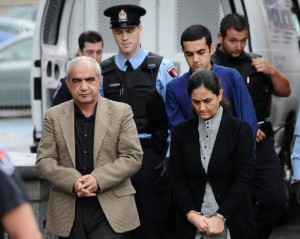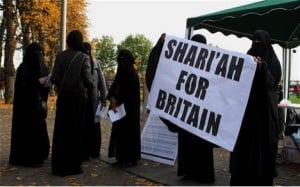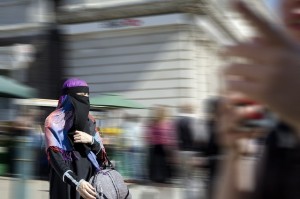On the morning of June 30, 2009 a quadruple-murder case rocked the city of Kingston in Ontario, Canada. Four women were found dead, submerged in the Rideau Canal, in their Nissan Sentra. At first it seemed as though boaters had come across a teenage prank gone awry or the victims of a horrific car accident.

However, as the bodies were identified as Zainab Shafia, age 19, Sahar Shafia, age 17, Geeti Shafia, age 13, and Rona Amir Mohammad, age 50, a grim and heartbreaking story began to emerge.
The three teenage girls were the biological daughters of Mohammad Shafia and Tooba Yahya, while Rona Mohammad was Mohammad Shafia’s first wife in a polygamous marriage. Shafia, whose family is originally from Afghanistan, reported his daughters missing to Kingston police that same morning. Less than a month later, on July 23rd, Shafia, his second wife, Tooba, and their 18-year-old son, Hamed, were charged with four counts of first-degree murder and four counts of conspiracy to commit murder.
The trial, which began just last month, has spawned fierce cultural and religious criticism from local media outlets. The culprit here is jejunely labeled Islamic values, and the motive dubbed “honor killing,” with prosecutors strategically using the concept of honor killings and positing Afghan culture—used synonymously with Muslim culture here—against “Western” culture. The result is a media debacle affirmed by the use of provocative and stereotypical verbiage in reporting on the trial.
In a statement exemplary of the types of sweeping strokes used to paint Afghan and Muslim culture throughout the trial—by the prosecution, defense, and local media—the Toronto Star’s columnist, Rosie DiManno undeniably ostracizes immigrant members of the Canadian Afghan community saying,
There’s a reason why the Justice Lady is blindfolded. It depicts objectivity—fairness and equality for all before the law. A disregarded concept in Afghanistan; a core value in the Canadian court system. Let us state the obvious: Canada isn’t Afghanistan. That culture is not our culture and their attitudes towards females are totally alien to ours.
Her numerous chronicles of the trial read like a distasteful orientalist novel with opening lines like, “Raise curtain, lift the veil, and step into the 12th century” (emphasis in original, so we don’t miss it), which trivializes the tragic deaths of four Canadian women in her futile attempt to artfully speak about murder—yes, let’s not forget we are speaking of murder here.
As if the media coverage of the trial weren’t grotesque enough, what seems to be unfolding in the courtroom is a theatrical display of outlandish finger pointing on all sides. The Crown Attorney seems to be prosecuting, not a murderous man and his female accomplice, but a Muslim man and his Muslim wife, and their cultural traditions which demand that they, in defending their honor against the threat of their daughters’ “un-Islamic” and” un-Afghan” behavior, carry out honor killings. In doing so the prosecution has drawn a huge divide between Afghan and Muslim culture and “Western” values, contributing to the growing Islamophobic sentiments surrounding the coverage of the case.
Even more damaging, these types of arguments require the prosecution to substantiate the “un-Islamic-ness” of the daughters, a scheme that has translated into vilified scrutiny of the eldest daughter, Zainab, and has raised extraneous questions of what it means to be a “good” Muslim woman, igniting the age old misappropriation of dress as a piety signifier.
Unfortunately, the Crown is not alone in stooping to new lows. The defense is also playing culture and religion cards, exploiting loose interpretations of Islamic values by accepting them as a way to put shame on those who failed to uphold them—a shame on the three daughters for failing to preserve their Islamic values, or shame on the father and mother if they failed to murder their daughters to preserve their honor. Whatever way you look at it, this type of sensational defense, justifying a criminal act on the basis of indecorous interpretations of cultural and religious values, is a foul embezzlement on the part of the defense, or as DiManno calls it, “a kind of inherently buffering otherness.”
Adding to the onslaught of religious misappropriation are the tactics of another Muslim party to this case. RCMP Inspector Shahin Mehdizadeh, a Farsi-speaking Iranian Muslim was called to interrogate the suspects. In his interrogation of Yahya, the Inspector coaxed and persuaded the woman to confess by appealing to religion. He says about her husband,
I don’t think he’s a bad Muslim who would go and have an affair…If they were uncontrolled kids, especially Zainab, if she was doing something to make your husband go mad, which a girl shouldn’t, especially an Afghan girl or a Muslim girl…’
Mehdizadeh even pleads with Yahya to confess by reminding her of her duty as “a good Muslim woman.”
Yahya’s defense lawyer capitalizes on this strategic invocation of religious commandments, saying that given Mehdizadeh’s “knowledge of Middle Eastern customs” if he was really concerned about Yahya’s being “a good Muslim woman,” he should have observed “cultural niceties” such as, having a third party present in the interrogation room. He tactfully uses this point to argue that Mehdizadeh’s “un-Islamic” interrogation methods would have made Yahya feel uncomfortable and intimidated, putting her under duress, thus making her confession null.
In the most obvious display of racism thus far, one of Shafia’s lawyers repeatedly uses the racial slur, “Paki,” in questioning a family witness about the Pakistani man Zainab had rebelliously married.
The trial seems to revolve around sustaining religious and cultural stereotypes, with both the defense and the prosecution referring to the murders as a way to avenge Muslim family honor. Perhaps the worst part is that these three young women are being maligned even in their deaths, reduced to playing the part of stock characters in this ugly melodrama.











